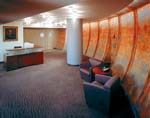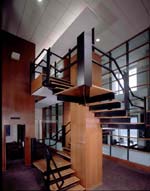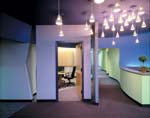
|

|
|
Home Site Search Contact Us Subscribe
|
|
New Name and New Directions: Boddewyn Gaynor Architects, DPC Q&A with the firm's principals about the changes they've made, and how they affect the firm’s operations and future plans. By ArchNewsNow.com September 1, 2015 Founded in 1974, Alan Gaynor + Co. has been a familiar name to the New York City architectural community for decades, but now that name – and much more – has changed. The new name, Boddewyn Gaynor Architects, DPC (BGA), reflects two significant developments: 1) Michele Boddewyn, AIA, who has served as the firm’s president for four years and has been with the firm for 35, is now the majority owner; and 2) The new Design Professional Corporation (DPC) designation means that, for the very first time, BGA can bring in non-architectural partners.
ArchNewsNow checked in with Boddewyn and Alan Gaynor, AIA, the founding principal of the firm, to learn more about the challenges and reasons underlying these developments and how they affect BGA’s operations and future plans. Here is what they had to say:
Why did you decide to rebrand as Boddewyn Gaynor Architects, DPC?
Alan Gaynor: Michele has played a major role in the success of the firm over her 35-year tenure. The name change is a way to acknowledge her leadership as president and her many contributions over the decades. But there are several other reasons we wanted to change the name. It better reflects the true essence of our collaborative working relationship, and we've been a Women's Business Enterprise (WBE) for several years. What's more, the previous name didn't acknowledge that we are architects. And, finally, having the words "and company" made it sound as if we were a construction firm, rather than an architectural practice.
Michele Boddewyn: And the timing is good, since we just celebrated the firm’s 40th anniversary.
Are you planning to step back, Alan?
AG: Absolutely not. We continue to work closely together. I have no plans to pull back. I thoroughly enjoy the challenge of developing innovative and creative design solutions for each of our clients. The satisfaction I have derived over the years is immeasurable.
MB: I wouldn’t allow Alan to step back, in any case. I really enjoy working with him, as do our clients. And it's also worth pointing out that Alan and I very much work as a team, because we each bring different but complementary skills to every client.
What do your clients think of the rebranding?
MB: We’ve explained to them that, basically, nothing has changed. One of us is still involved in every project. Our priorities are the same – to creatively balance functionality and design, focus on the end users' needs, be detail oriented, and deliver projects on time and on budget.
Please explain the new DPC designation and what that means for BGA moving forward.
MB: As of 2012, design firms in the state of New York can form a DPC, which allows people without an architectural license to have an ownership interest of not more than 25% in a firm, as long as at least one of the other shareholders is licensed. This means that, in the future, we can bring on partners who need not be architects, but whose experience, skills, and new-business acumen complement ours. As the architectural industry continues to transform itself in the upcoming years, we may find that bringing in such a partner makes sense.
AG: It’s great to have this option available to us.
When did you become a Women’s Business Enterprise?
MB: We became a WBE in 2010, after I became president.
How did your clients and business associates react to the WBE designation?
AG: The response was overwhelmingly positive. As you know, there is a dearth of women in leadership positions in the A/E/C industry, so people saw it as a welcome indication of where the industry is headed.
How many people are you now?
MB: 15
What are your immediate goals for BGA?
MB: We would like to expand our services to more segments of the market, including larger scale building-related projects, such as building conversions and more complex interiors, both corporate and institutional. The value that a good architect brings to the table in terms of innovative, customized design cannot be overstated. In other words, we're very proud of the fact that we don't utilize the same solution over and over again. Each project must reflect the client's personality, needs, and image. A good architect shouldn't be interested in designing a project to promote his or her design interests; the focus should always be on the client and what is best for them.
How is the profession changing?
AG: Technology has impacted many professions, and architecture is no exception. The ability to craft designs utilizing 3-D software is exciting and tantalizing; so much can be done. That being said, young professionals must bear in mind that designs must be implemented, and buildings must be operated and properly maintained. That’s where experience needs to step in and lead the way to a practical and meaningful solution. With the blend of new technology and time-tested knowledge and experience, it’s a thrilling time to be an architect.
What are some of the key projects you’ve completed over the years?
AG: We have had the privilege over 40 years of serving many fine organizations, including: Weill Cornell Medical College, The Weather Channel, The New York City Human Resources Administration, and Vornado Realty Trust. And recently we've done significant building conversions in New Jersey, and The Halsted and The Althea apartment buildings in East Orange, NJ.
One of our most recent projects involves the replacement of 5,000 deteriorated single-glazed, steel windows at the iconic Starrett Lehigh Building in Manhattan’s West Chelsea neighborhood. BGA’s challenge was to match the existing window size and profile to the satisfaction of the NYC Landmarks Preservation Commission. An exciting aspect of this project involved our collaboration with a window manufacturer to design custom extrusion profiles and sightlines in response to the commission’s feedback. Now, with the commission’s approval, we are addressing the issues of fabrication and installation with our client, RXR Realty, during the upcoming three-year phased implementation.
And, finally, if there was one thing you would want your clients and prospects to know about you, what would it be?
MB: We are passionate about architecture and design, and are committed to excellence. |
(click on pictures to enlarge)  Mark Darley New York City headquarters for London-based securities trading firm Smith New Court (reception area).  Roy Wright The reception area for the marine insurance company WQIS (Water Quality Insurance Syndicate) is designed to resemble the inside of a ship’s hull with curved and sloped walls in a faux rusted-metal finish.  Boddewyn Gaynor Architects WQIS reception area display  Paul Warchol A cantilevered steel stairway connects the two floors of Carl Marks & Co., an investment banking and real estate firm.  Roy Wright The reception area and main conference room of IntraSphere, a web design and integration firm.  Paul Warchol BBC/Worldwide Americas reception.  Paul Warchol BBC/Worldwide Americas elevator lobby.  Roy Wright Excite@Home New York sales office.  Roy Wright The Posse Foundation’s main program area. |
© 2015 ArchNewsNow.com